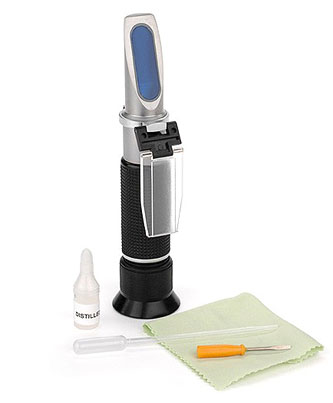 As you progress in your wine making practice, you may find yourself making wine from grapes (if you aren’t already). Taking it a step further, you may find yourself gaining access to grapes that are still on the vine, allowing yourself much more control over things like: when the grapes should be picked.
As you progress in your wine making practice, you may find yourself making wine from grapes (if you aren’t already). Taking it a step further, you may find yourself gaining access to grapes that are still on the vine, allowing yourself much more control over things like: when the grapes should be picked.
Now that you’re diving into the realm of viticulturalist, you’ll need to become familiar with one piece of wine making equipment that is a must-have for all those making wine from grapes.
The wine refractometer is a piece of equipment that you must have if you will be in charge of determining when to pick your grapes. Before you harvest your grapes, you want to be sure the grapes have matured to a particular sugar level best suited for a well-balanced finished wine. Wine refractometers act to measure the Brix present in the grapes, thus allowing you to determine if they are ready to be harvested or if they need to remain on a vine for a longer period of time.
Wine refractometers work by using light to measure the density of water-soluble compounds in a sample. What these devices are actually measuring is the refractive index of a fluid sample. Basically, as light travels through a sample, it will move faster or slower depending upon how dense the fluid is. The denser the sample is, the slower the light will refract, and the higher the value on the refractometer is read. In other words, the more sugar that is in the sample, the more dense the sample is, thereby the reading on the wine refractometer will be higher than if it was a sample of pure water (less dense than a sugar solution). Here’s more information on how a wine refractometer works.
Wine refractometers come is various styles and designs and all are functionally very similar. To operate a wine refractometer, you’ll need a grape sample. Ideally, you’ll want to take multiple samples throughout the vineyard to check for variation in maturation times (you may want to harvest different sections at different times). You’ll want to try and harvest those grapes that are all at the same stage in their maturation process, in order to create a more balanced wine.
Next, squeeze the grape into a plastic bag in order to release the juices. Then, place a couple of drops onto the refractometer, close the attached cover, and peer into the device while holding it up to the light. The reading will be clearly marked on striations inside the device, allowing you to determine if the grapes are ready to be harvested or not.
There is a lot to learn once you’re at the point of harvesting your own grapes, however, the refractometer is certainly one piece of equipment you’ll never want to be without.
Happy Winemaking,
Ed Kraus
———————————————————————————————————
Ed Kraus is a 3rd generation home brewer/winemaker and has been an owner of E. C. Kraus since 1999. He has been helping individuals make better wine and beer for over 25 years.

RE: Topping off the wine
Prepare yourselves….I’m going to stick a pin in a beloved Holy Cow.
Much has been said about going to the trouble of topping off the wine in the secondary fermenter (usually a carboy). We, for a number of years have made what many others consider the best wine they’ve ever tasted. Supposedly, topping off (reducing the ullage) reduces also the natural atmospheric gasses containing oxygen which will oxidize the wine. While I’ll agree we don’t want to oxidize our wine this simply won’t happen as fermentation continues within the carboy creating carbon dioxide which quickly purges the oxygen from the vessel through the bubbler. Therefore, "topping off" won’t hurt but it wont do any good either. Our wine has never oxidized (browned) and is a favorite among many people. Never argue with success. I hope this bit of heresy hasn’t upset anyone.
Finally, we’ve developed a detailed procedure (recipe) for our winemaking which I would be glad to share with anyone who might be interested.
Happy wine making to all!
Logan
I agree with you, Logan, if you are bottling in 3,4, maybe 5 weeks. For those of us that wait 5 or more months, long after fermentation ceases (and rack 3, 4, maybe 5 times), I don’t agree. I prefer to let my wine (from concentrates) sit for at least 5 months, and my wine (from fresh fruit) sit at least 7 months to allow the wine to naturally clear. The wine only gets better, and clearer with time – no hurry !
To LOGAN, I enjoyed your comments dated Aug. 26. I am very interested in your procedure (recipe) for winemaking. I am making my first batch of wine from my own grapes soon, and can use any advice that you have. Thank You. Ron